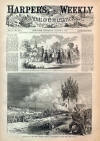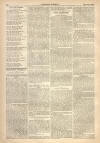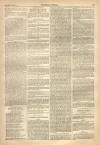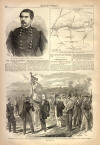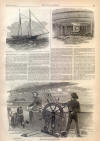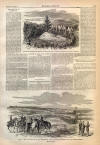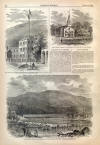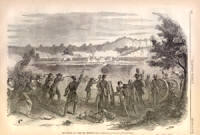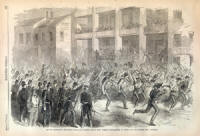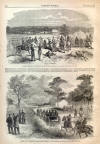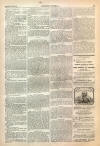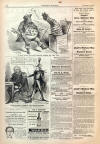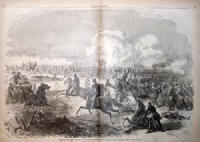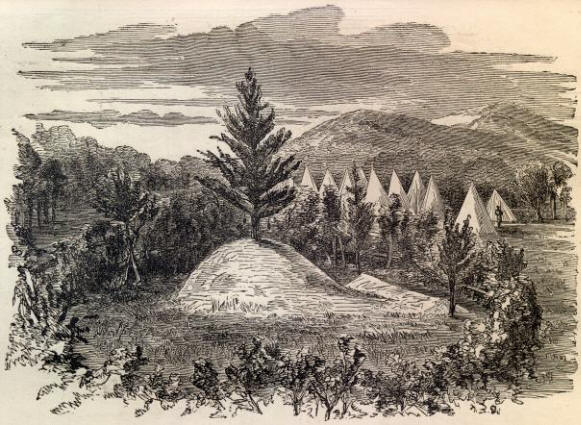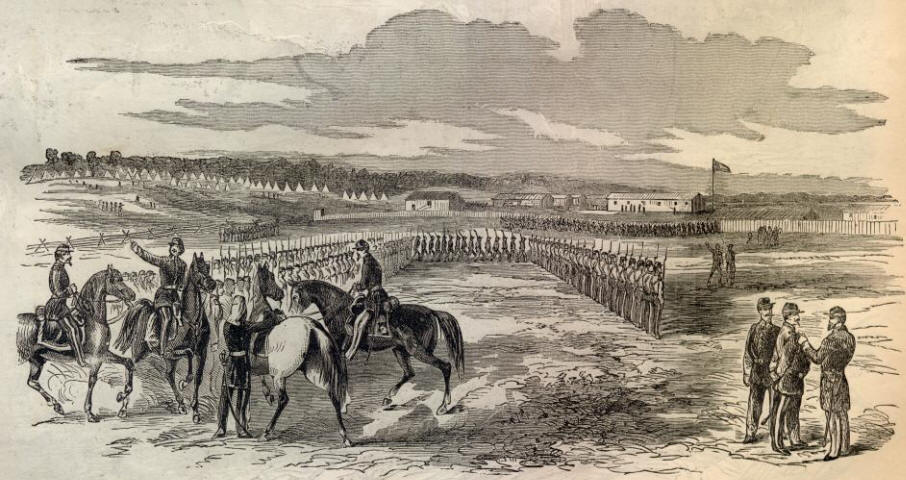|
This Site:
Civil War
Civil War Overview
Civil War 1861
Civil War 1862
Civil War 1863
Civil War 1864
Civil War 1865
Civil War Battles
Confederate Generals
Union Generals
Confederate History
Robert E. Lee
Civil War Medicine
Lincoln Assassination
Slavery
Site Search
Civil War Links
Civil War Art
Revolutionary War
Mexican War
Republic of Texas
Indians
Winslow Homer
Thomas Nast
Mathew Brady
Western Art
Civil War Gifts
Robert E. Lee Portrait
|
THE BATTLE OF
CARTHAGE.
ON
page 486 we illustrate THE
BATTLE OF CARTHAGE,
where Colonel Siegel, of the United States Volunteers of Missouri, kept at bay
and severely punished a very disproportionate force of rebels, under Generals
Parsons and Rains. The
St. Louis Republican gives the following account of the
affair :
On Friday morning last, at five
o'clock, a scouting party sent out by Colonel Siegel encountered, about two
miles distant from Carthage, a picket guard of the State troops, who were
attacked, and three taken prisoners. With all dispatch Colonel Siegel prepared
to go forward, expecting to meet the State troops some distance west of
Carthage. About half past nine o'clock the meeting took place in an open prairie
seven miles beyond Carthage. Lieutenant Tosk estimates the number of the
opposing army at five thousand, chiefly cavalry, but supplied with a battery of
five cannon—four six-pounders and one twelve-pounder—while Colonel Siegel's
command consisted of his own regiment of two battalions, and Colonel Salomon's
detached regiment, with several pieces of artillery, under command of Major
Backof. Colonel Siegel's regiment had six hundred men, and Colonel Salomon's
five hundred. The State troops were commanded by Generals Parsons and Rains.
Major Backof, under the direction
of Colonel Siegel, opened the
fire, which continued briskly for nearly two hours. In less than an hour the
twelve-pounder of the State troops was dismounted, and soon after the whole
battery was silenced. The superior arms of the Unionists enabled them to
maintain a situation of comparatively little danger. The State troops—whom, for
convenience, we shall call Jackson's men—twice broke their ranks, but were
rallied and held their position very well, considering the destructive
discharges against them, until their guns gave out, when their column was again
broken. At this juncture about fifteen hundred of the cavalry started back with
the intention of cutting off Siegel's transportation train, seeing which
movement a retreat was ordered, and word sent immediately for the wagons to
advance as rapidly as possible. By keeping up the fire with the infantry, and
bringing the artillery in range whenever practicable, Colonel Siegel managed to
retard the progress of Jackson's cavalry, and eventually to fall back almost
unobstructed to the baggage train, which was some three and a half miles from
the scene of the first engagement.
By a skillful movement the wagons
were placed in the centre of the column in such a manner that there were
artillery and infantry forces both in front and rear. Jackson's troops then
retreated and endeavored to surround the entire column by taking a position upon
some high bluffs or hills overlooking a creek.
Major Backof ordered two of the
artillery pieces in front to oblique to the left and two to the right, and at
the same time a similar movement was made from Colonel Siegel's battalions. This
was a manoeuvre to induce Jackson's men to believe that Siegel was seeking to
pass out on the extremes of their lines, and to outflank the cavalry. It was
followed by a closing up to the right and to the left by the forces on the
bluffs, when, on reaching a point three hundred and fifty yards from the
cavalry, the four pieces were ordered to a transverse oblique, and immediately a
heavy cross-fire was opened with canister. At the same time the infantry charged
at double-quick, and in ten minutes the State troops were scattered in every
direction. Ten rounds of canister were fired from each of the
cannon, together
with several rounds by the infantry.
This was at about five o'clock in
the evening,
and the engagement, with the
manoeuvring, had occupied in the neighborhood of two hours. Jackson's cavalry
were poorly mounted, being armed chiefly with shot guns and common rifles. They
had no cannon on the bluffs or hills, and were consequently able to make little
or no resistance to the attacks of Colonel Siegel. Forty-five men and eighty
horses were taken belonging to Jackson's troops, and there were also captured
sixty double-barreled shot guns and some revolvers and bowie-knives. Our
informant states that one of the prisoners, on being asked how many had been
killed on his side, estimated the loss at from two hundred and fifty to three
hundred.
GRAVES OF THE OHIO VOLUNTEERS.
NINE members of the First
Regiment Ohio Volunteers were killed in the affair at Vienna on the 17th of
June, 1861. They were buried in the rear of their encampment near Roach's Mills,
Virginia, on the 18th, and the same day the encampment was removed to a point
five miles beyond, on the road to Vienna. On the evening of the 18th the Third
Regiment New Jersey Militia occupied the ground vacated by the Ohio troops.
Finding the graves unprotected, by direction of Lieutenant-Colonel Stephen Moore
the Jersey troops built a neat fence of cedar branches around the graves. Under
the mound are the bodies of eight men, and in the grave in front lies the body
of the sergeant, who died after the others were buried. A few days after the
burial the place was visited by some of the officers of the Ohio Regiment, and
after their departure two Masonic emblems (a small gilt slipper and a triangle
containing the letter " G") were found hanging on the cedar planted in the
centre of the mound.
GENERAL HILL'S HEAD-QUARTERS.
ROWLESBURG, the head-quarters of
General Hill in Western Virginia, is situated in a deep gorge in the Alleghanies,
at a point where the Baltimore and Ohio Railroad crosses Cheat River. The
scenery around it is bold, grand, and picturesque, shut in by towering
mountain-walls, the dark stream
flows silently on, overshadowed
with dense forests of hemlock and laurel. This region of country is wild and
thinly populated, and deer and bear roam unmolested along the thickly-wooded
slopes. The little village has sprung up since the opening of the railroad, and
has become quite a thriving place. General Hill is at present concentrating all
his troops at Rowlesburg, by older of
General McClellan, for the purpose of
cutting off the retreat of the Confederates lately under Garnett, at St. George.
The illustration will be found on
page 490.
WE publish on page
484 a
portrait
of MAJOR-GENERAL M'CLELLAN, U.S.A., whose brilliant victories in Western
Virginia we have already illustrated. We subjoin an authentic account of General McClellen's career : He was born in Philadelphia on December 3, 1826. At the age
of sixteen he entered the Military Academy at West Point, graduating with the
class of 1846, with the rank of Brevet Second Lieutenant of Engineers. Until the
Mexican war, however, he had no opportunity of distinguishing himself, and then,
"for gallant and meritorious conduct in the battles of
Contreras and
Churubusco," as the orders expressed it, he was breveted First Lieutenant. " For
gallant and meritorious conduct at the
battle of Molino del Rey," on September
8, 1847, he was offered a Brevet Captaincy, which he declined. He was advanced
to this rank, however, subsequently, "for gallant and meritorious conduct at the
battle of Chapultepec," and received the command of a company of sappers,
miners, and pontoneers in May, 1848. At the close of the Mexican war he returned
to West Point, where he remained on duty with the sappers and miners until 1851.
During this time he introduced the bayonet exercise into the army, and
translated and adapted a manual which has since become a text-book for the
service. During the summer and fall of 1851 he superintended the construction of
Fort Delaware, and in the succeeding spring was assigned to duty, under Major R.
B. Marcy, in the expedition for the exploration of the Red River. Thence he was
ordered direct to Texas, as senior
engineer, on the staff of
General Persifer F. Smith, and engaged for some months in surveying the rivers
and harbors of that State. In 1853 he was ordered to the Pacific coast, in
command of the Western division of the survey of the North Pacific Railroad
route. He returned to the East in 1854, on duty connected with the Pacific
survey, and was engaged also in secret service to the West Indies The next year
he received a commission in the First Regiment of Cavalry, and was appointed a
member of the commission which went to the seat of war in the Crimea and in
Northern Russia. Colonel Richard Delafield, one of his colleagues, is now an
officer in the rebel army, and Major Alfred Mordecai, the third member of the
Commission, a short time ago resigned the Superintendency of the Troy Arsenal.
Major McClellan's report on the "Organization of European Armies and the
Operations of the War," a quarto volume, embodying the result of his
observations in the Crimea, greatly enhanced his reputation as a scientific
soldier. In January, 1857, weary of inaction, he resigned his position in the
army to become Vice-President and Engineer of the Illinois Central Railroad,
which post he held for three years, when he was offered and accepted the
Presidency of the
Ohio and Mississippi Railroad, of which he was also General
Superintendent. When our domestic
troubles assumed formidable dimensions, Major McClellan's services were at once
called into requisition. Governor Curtin, of Pennsylvania, tried to secure the
benefit of his experience in organizing the volunteers from that State; but the
tender of the Major-Generalship of the Ohio forces reached him first, and he at
once accepted it. On May 14 he received a commission as Major-General in the
United States Army, and now has command of the Department of Ohio, which comprises all of the States of Illinois, Indiana, and Ohio, and that part of
Virginia lying north of the Great Kanawha River and west of the Green Brier
River and the Maryland line, with so much of Pennsylvania as lies west of a line
drawn from the Maryland line to the northeast corner of M'Kean County.
PRESENTATION OF A FLAG TO
THE WEBSTER REGIMENT.
ON
page 484 we illustrate the
presentation of a flag by Edward Everett, on behalf of the ladies of Boston, to
the Webster Regiment, at Boston, on July 18, 1861. In presenting the flag to
Colonel Fletcher Webster, Mr. Everett said, among other things:
You are entering, Sir, with your
patriotic associates, upon an untried field of duty, but you are descended from
a stock which, in more than one generation, teaches lessons of loyal devotion.
Your grandfather, Captain Ebenezer Webster, a grave and thoughtful man, was one
of those brave frontier rangers who bore the brunt of the seven years' war in
the wilderness which separated our then feeble settlements from Canada, and he
stood with Stark at Bennington. Your noble father, in defence of the menaced
Constitution of the country, led those mighty conflicts of the Senate, not less
arduous, not less decisive, than the conflicts of the field. Your only brother,
following the impulse of a generous ambition, left his young life on the sickly
plains of Mexico. On the family record that hears these proud memories, nothing
less worthy than duty faithfully performed, danger bravely met, and the country
honorably served, will ever, I am confident, be inscribed in connection with
your name.
GRAVES OF THE OHIO VOLUNTEERS,
NEAR ROACH'S MILLS, VIRGINIA.—[SKETCHED BY AN OHIO VOLUNTEER.]
CAMP OF THE FIRST BRIGADE OF
THE CONFEDERATE ARMY, ON THE FAIR GROUNDS, NEAR WINCHESTER, VIRGINIA.
[SEE PAGE 490.]
|
